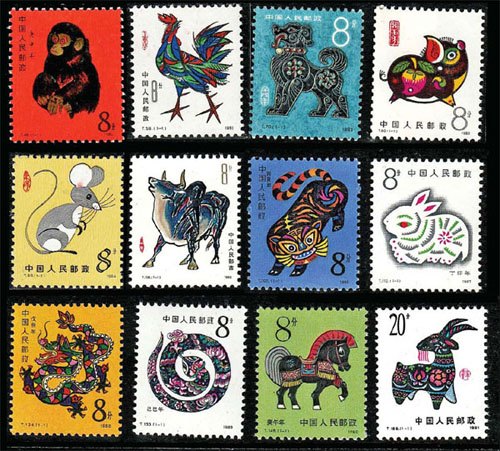
The 12 stamps of the first set of Chinese zodiac signs from 1980 to 1992.
China Post seems to agree and each year, it invites renowned Chinese artists to submit designs for the zodiac stamps. Their contributions are assessed by a committee of experts and officials.
In the early years, it was a sacred task when an artist was asked to design the zodiac stamps. Early designers of the first zodiac stamps included prominent names such as master painter and sculptor Han Meilin and Zhou Lingzhao. The latter is the artist who created the third version of Chairman Mao Zedong's portrait, which was used for the founding ceremony of the People's Republic of China on Oct 1, 1949.
In the early days, too, it was more art than technology. Stamp printing used a technology that combined engraving (where the image was first incised by hand and then printed onto the stamps) and heliography. One advantage of that technology, Geng says, is that the image came out really vivid and stereoscopic.
For example, you can clearly see the detailed lines on the monkey fur. The monkey's facial expression was equally detailed and true to life, with the gilded eye a particular highlight.
For Yang Yao, a young but experienced stamp collector who works at China Post's Jiangsu Branch, this old-fashioned technology is what distinguishes the zodiac stamps from those issued by other countries.
In 1950 Japan was the first country to issue zodiac stamps, and now more than 90 countries regularly issue zodiac stamps. Many of these, especially Western countries, commission Chinese artists for the designs.
China's unique stamp-making technology still sets its zodiac stamps apart, for their "authentic Chinese flavor", Yang says.
But Geng grows nostalgic. The latest and current series of zodiac stamps has already abandoned part of the old method and uses only a heliographic (photographic) process, to minimize damage to stamps during printing.
Geng is updating his philatelic encyclopedia, and he notes that all the background knowledge about art and history is what makes it fun for the stamp collector. It requires an investment of time and patience to read and study, something he and his wife have been doing for decades.
"As the old adage goes, stamp collecting increases knowledge. This little postage stamp is truly a small encyclopedia," he says.

Copyright ©1999-2011 Chinanews.com. All rights reserved.
Reproduction in whole or in part without permission is prohibited.